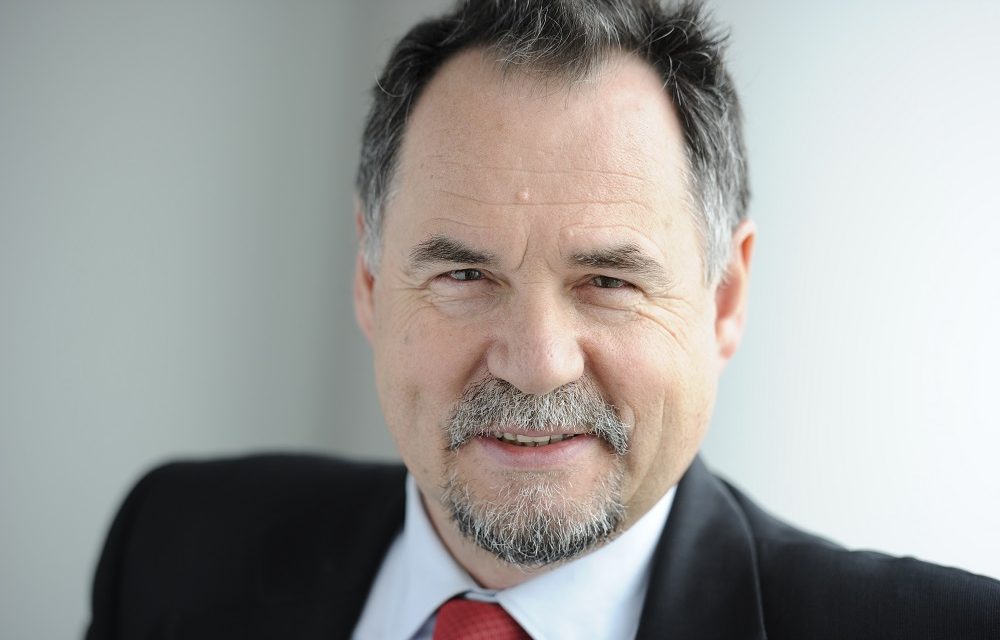« Often humbled, sometimes vindicated, always intellectually stimulated »
Some thoughts after 30 years in the economic analysis business
In early July 2016, I sent to clients, colleagues and friends my very last ‘Blue Book’ in my capacity of AXA’s chief economist and head of Research at AXA IM. Back in 2009, this thick slide deck was dubbed the ‘Blue Book’ after a lunch with senior Chinese businessmen in Shanghai, during which we evoked the testing times of China’s Cultural Revolution and Mao Tse-Tung’s Little Red Book. Several of my counterparts, who were students during the Cultural Revolution, spent most of their youth in remote People’s communes, toiling day and night and, despite being exhausted, having to read and comment the famous little book every morning and evening. That’s probably why they welcome the Blue Book with bursts of laughter. Together with the publication, I decided to write down some thoughts, as a tentative legacy. The following is an edited and updated version of this letter.
In the immediate aftermath of the Great Financial Crisis, it was not easy to figure out what was going on in the global economy and financial markets and what were the most likely developments going forward. Back then, I was calling for a ‘deep-V’ cyclical pattern, which by and large turned out correct, but I did not grasp the longer term consequences of the crisis, which include a dramatic slowdown of global trade, a fall of its elasticity relative to global growth as well as a fall of the equilibrium real rate of interest. Despite an ever growing set of data, analysis and personal experience, I am afraid short term economic analysis has not become easier by any means. I will try to do just that for starters but I will not stop there. Over my thirty years in this business, first in the French civil service (INSEE and Treasury), then in the investment banking world and, for the last eight years as AXA group’s chief economist, I always had to take side in macro-financial debates. I was often humbled by the subsequent facts, sometimes vindicated, always intellectually stimulated.
A quick glance at the global economy
Global growth seems to be on a mini roller coaster: a slightly encouraging quarter following a string of disappointing ones. As for the G-4 (US, €-area, China and Japan), GDP growth accelerated to 3.8% (quarterly annualised rate) in Q3 after 2.7% on average over the previous three quarters. This is not bad at all, given that the acceleration came from the US and China. In the latter, the good news was a slight acceleration in nominal GDP growth, a key gauge for an economy overburdened by corporate debt (205% of GDP). A mix of targeted fiscal stimulus and yuan depreciation was instrumental to fend off –for now—the threat of deflation. Is this sustainable? There is a lively debate among the Chinese leadership on the most effective and least harmful way to deal with ‘zombie’ SOEs, but as any other highly leveraged economy, China cannot skip the painful process of restructuring inefficient companies and cleaning up the banking system of its non-performing assets. Stronger nominal growth makes the adjustment less painful, but it might also encourage procrastination.
US growth is robust but relies excessively on consumers
In the US, where all the buzz is on President-elect Donald Trump’s future economic choices, the good news is, real economic growth continues to be fuelled by households’ spending and investment, supported by robust employment growth and now fully repaired balance sheets. Yet, US companies are clearly reluctant to increase capital expenditures, their profit margins having peaked out, and net exports not being of any help in a world where global trade of manufactured products is growing at a snail pace, close to 1% p.a.. This is clearly an element of fragility in the maturing US cycle, which has made the Fed ever more cautious on its normalization path. Yet, if anything is robust in candidate Trump’s electoral promises, it is probably 1/ some public spending to kick start spending on infrastructures, 2/ corporate tax cuts and unwinding of the regulation bridling sectors such as oil exploration and extraction and, perhaps, banks and other financial institutions. This is at least how the financial markets are translating the news, with long term interest rates rising abruptly on expectations of higher inflation, and financial stocks skyrocketing. A fiscal expansion based on corporate tax cuts and spending on infrastructures would be indeed good news for the US and the global economy, since it would help add another leg to the already 8-year-old US cycle, and contribute to raise the global equilibrium real rate of interest, thus allowing the Fed to normalize its policy rates without taking the risk of causing an unwanted recession.
Yet, there are three caveats to this rosy outlook. First, Trump’s promises were often self-contradictory: fiscal expansion and debt reduction; unwinding of Dodd-Frank-Volcker regulation to boost bank lending and higher protection for consumers and small businesses; call for a reduction of the Fed’s balance sheet and hope that the Fed will not spoil the party even if inflation comes back. Interestingly, post-election, the rise of long term interest rates came from the implicit term premium, as measured for instance by the Fed of New York (see Adrian-Crump-Moench ACM model) not from anticipations of faster policy normalisation by the Fed. Second, a significant shift toward protectionism would harm the US economy, perhaps causing the recession many are fearing at the 2018 horizon, and, if emulated elsewhere in the world, would wreak havoc on a very fragile global economy. Third, any attempt to rein in the Fed to prevent the FOMC to check future inflation, may cause a much larger bond market rout than we have seen so far, potentially tipping the investment recovery.
Brexit: the short term cost was not the issue
Turning to Europe, the Brexit debate is much less passionate and acute than a few months ago. What was only a suspicion before the referendum is now a certainty: no one in the Brexiter camp had thought about a plan on how to leave the European Union. The new Conservative cabinet led by Mrs May will eventually come up with a strategy going beyond pulling Art. 50 trigger, now that the Parliament has given its okay, in March 2017. In the meantime, other EU countries will try to agree on a common strategy of their own, with little hope of an ambitious plan before the French and German elections are behind us. The consistency asymmetry in negotiating strategies on both sides of the Channel will slightly reduce the larger asymmetry stemming from relative sizes: beyond political debates, the fact is that UK exports to the EU makes 12.5% of its GDP, vs. 2.5% for EU exports to the UK. To the surprise of many forecasters, starting with HM Treasury and the Bank of England, the short term cost due to higher economic uncertainties has not shown up –GDP growth reached 2.0% in Q3, above all its continental peers but Spain. With the proverbial benefit of hindsight, a free floating currency proved again to be a great asset: from May to November 2016, the effective exchange rate of the pound fell by 12%, a welcome boost to British companies earnings as well as a powerful support to the ailing UK balance of payments, thanks to the automatic appreciation of overseas incomes. Moreover, expected inflation, as measured by 5-year inflation swaps, has increased by 0.8 pp, thereby slashing real interest rates and doing the job that the Bank of England had not been able to deliver so far, that is, raising inflation expectations to a level consistent with its own 2% inflation target. Overlooking these mundane macro fundamentals probably explains why forecasters were too gloomy, at least for the short term.
The issue was, still is, the long term prospect for the United Kingdom and Europe
With the fog now partly dissipated, the real stakes of the referendum are appearing in crude light. First, Brexit means hard Brexit. Even if a transitory status is granted to the UK once the L-day has come, as many on both sides of the Channel are calling for, this will not change the fact that the UK will no longer have a preferential access to the EU single market, and that it will take several years before new trade deals are agreed upon. Unavoidably, UK-EU exchanges of goods and services will be scaled down while trade flows with the rest of the world will not change fundamentally, whatever the efforts made by the UK government and UK companies. One of the most robust ‘law’ in economics is the gravity equation in trade. If such law has proved little sensitive to dramatic institutional changes in the past two hundred years (perhaps over the last 3,000 years, some academics think), they are unlikely to yield to the optimism of brexiters. Like it or not, Brexit will exact a tribute from the UK economy, starting with the purchasing power of households. This does not make me overly pessimistic for the UK in the longer run. Great Britain will have to adapt and the odds are that this will happen. Thanks to Margaret Thatcher’s Big Bang, London became the first international financial hub in the world, even though the price to pay was hefty: after the demise of Barings in 1995, not a single British merchant bank survived the arrival of American and then European barbarians (read investment banks). This kind of tough Darwinian adaptation seems to continue. Since the financial crisis and its by-product, a much tighter regulation that has dented banks’ profitability, London has started to shift from finance to technology and has actually become the most powerful technology hub in Europe, in key areas such as artificial intelligence and genetics, heralded by companies such as DeepMind (now owned by Google) or the Francis Crick Institute. Yet, there is a necessary condition for the UK to adapt and thrive again in the longer run: the British economy must remain as open and flexible as it is today, a feature at odds with the xenophobic reaction of many brexiters.
* * * * *
Overall, the global economy remains on a slow growth path, slightly below 3% in real terms but still safely away from the recession threshold. In addition, growth is more evenly distributed among geographies than was the case in the previous years. Yet, such a sluggish momentum makes the world vulnerable to potential political or financial shocks, not a scarce commodity these times. This is the world in which we have been sailing since 2013, after the post crisis recovery and it is time to ponder about it more in depth.
Ask where we come from before asking where are we going
We are still in the aftermath of the ‘Great Financial Crisis’ (GFC). Therefore, a forward looking view must start with an assessment of the roots of the crisis. Since it took almost 60 years to close the debate between John Maynard Keynes and Milton Friedman on the cause of the Great Depression (Ben Bernanke did it), it is certainly presumptuous to do just that ‘only’ 8 years after the facts, but we don’t have the luxury to wait for another 50 years, do we? I have two observations. First, financial deregulation, seen by a large majority of analysts and highly rated economists such as Raghuram Rajan (who made his point before the crisis, see here his warning about the ‘tail risk’ in 2005) for instance, is partly responsible. In 2003, the US financial sector grabbed 41% of all corporate profits in the US. It doesn’t take a Nobel award to understand that something was wrong in the leading economy. Yet, concluding that financial excesses were the only or even the most important cause of the GFC and its long term consequences, is short sighted in my view. The most important event that reshaped the global economy and financial markets post 1990 was the deafening entry of China in the global economy, with an export-led catch-up strategy, which has been the most successful ever measured (for a large economy at least) and had very deep consequences for the rest of the world, one of them being to drag down the global real rate of interest for a period of time long enough to fuel asset price bubbles in most parts of the world. As Dr. Keyu Jin and her co-authors have brilliantly shown, the one-child policy designed in the early 1980s to prevent famines, has also contributed to the rise of the Chinese savings rate and therefore to the fall of real rates (see this preview of their AER paper). Since the financial sector is now under close scrutiny and has to comply with tighter capital rules, and since China’s policy and thus the dynamics of its current account, have changed, we are now in a very different world.
The secular stagnation hypothesis and its consequences
The causes of the GFC may have vanished, but we are nevertheless living under its long shadow. Since Lawrence Summers put forward his ‘secular stagnation’ (SSt) hypothesis, I must admit that it has fit nicely with the facts: sluggish global growth, very low inflation and nominal interest rates. Summers posits that the equilibrium real rate of interest is so low (i.e. deeply negative) that even unconventional monetary policies cannot match it, without venturing ever deeper in negative land (see Summers’ Vox post with Gauti Eggertson). I have come to the view that this is the best starting point at our disposal to understand the new normal. To some extent, Nomura’s chief economist Richard Koo, with his balance sheet recession framework, had paved the way for the secular stagnation hypothesis many years ago (see a nice summary of Koo’s thesis in this Nomura research note). I must admit that I have been reluctant to embrace this school of thought, because of some shortfalls (if fiscal stimulus is the solution, then why is Japan still close to deflation? Koo’s answer is simple: fiscal stimulus was useful but ‘too late too little’). For that reason, I have been slow to accept that bond yields would remain lower for longer than expected, say, in 2013. Interestingly, the rigorous analysis of the yield curve structure provided by the split of yields into a risk-adjusted component (geometric average of risk-adjusted forward short term rates) and a term premium provided by the ACM model, shows that financial markets continue to expect central banks to raise policy rates in the next few years, and that the fall in bond yields from 2013 to early September 2016 is mostly due to the fall of the term premium, itself largely a by-product of quantitative policies. Then, we have walked the full circle: central banks have massively increased their balance sheets in order to lower bond yields, because the equilibrium rate was even lower, which is the root of SSt and the structural reason why yields are so low. I see two important consequences stemming from the SSt stagnation hypothesis: first, bond yields may continue to stay low over the next few years, at least in the €-area and Japan. Second, if as seems likely, fiscal policies will not do their full part of the job, global potential growth will continue to slow, for lack of productive investments, until global potential supply and actual demand meet each other. That day, perhaps in 3 to 5 years, cyclical inflation will come back on a global scale, despite very sluggish growth. Inflation future markets are already tentatively pricing in a normalisation of inflation in the UK and, to a lesser extent, in the US. These are signs deserving attention.
Will Trumponomics spoil the party? The danger of “secular stagflation”
The spectacular rise in US Treasuries yields since the vote in favour of Donald Trump (60 bps) seems to be at odds with this key feature of secular stagnation, low nominal rates. Yet, I think it is too early to shelve the secular stagnation hypothesis. Here is why. First, the rise in yields is almost entirely explained by higher inflation expectations, which implies that the real rate of interest has not significantly increased. In other words, markets do not anticipate a sustainable rise in long term economic growth. Is the equity rally telling a different story? Not really, since US markets have mostly reacted to the prospect of corporate tax cuts, which will increase short term profits with no obvious impact on long term growth. Second, the rise in bond yields is, according to the ACM model, fuelled by a sharp rise of the term premium, not expectations of higher policy rates, allegedly reacting to higher nominal GDP growth. Third, if a Trump administration delivers substantially on protectionism, higher inflation, not faster potential growth, would follow.
So, yes, Trumponomics may spoil the party, but by hastening the return of inflation, not by solving the secular stagnation disease via stronger potential growth. Put differently, Trumponomics may result into “secular stagflation”. Hopefully, stronger productivity growth will spare us from this dangerous world. The surge in productivity will come from the formidable pipeline of scientific and technological innovation accumulated over the last twenty years, which has not yet diffused through the global market place. As we have learnt from Robert Solow, who, in the mid-nineties, was complaining that computers were everywhere except in productivity data, precisely when productivity was on the verge of accelerating sharply, predicting productivity trends is challenging. Yet, the surge may come earlier than the pessimistic camp (represented by Robert Gordon for instance) thinks if the diffusion of technology is boosted by the rapid spread of artificial intelligence (AI), via deep machine learning, in a large range of sectors, and not only in advanced economies –think of the massive AI investments by Chinese companies such as Ali Baba or Baidu.
Toward an overhaul of the monetary and financial systems, with a little help from blockchain?
A large excess of credit supply was a clear forerunner and intermediate cause of the GFC and of its consequences, including quantitative policies. The most convincing evidence of this is presented in Moritz Schularick and Alan M. Taylor study of leverage cycles from 1870 to 2008 (see this version of their AER paper posted by the Fed of San Francisco). For that reason, policy makers of the world have decided to weave mandatory straitjackets for all financial institutions, deemed to be the mothers of all excesses, so that the GFC would ‘never happen again’. As was predicted by seasoned academics such as Charles Goodhart, financial re-regulation had many unintended consequences, because of the genetic pro-cyclicality of regulation. As a result of secular stagnation, quantitative policies and tighter financial regulation, everyone seems unhappy, from central bankers who complain that they are ‘the only game in town’, to bankers and investors who are crushed by negative rates and even systemic risk watchers, who are not convinced that banking systems are now safe.
I am tempted to think that such a high level of discontent, compounded with the popular resentment against globalization and the role of global finance, will continue to swing the policy reform pendulum. This time, the change could be spurred by technology. Some scholars, starting with Michael Kumhof when he was at the IMF, have revisited the ‘Chicago plan’, designed in the late 1930s as a reform of the monetary system aiming at preventing credit bubbles by taking the power to create money from credit institutions’ hands and concentrate it in those of the central bank (see Kumhof working paper written with Jaromir Benes). It happens that there is a technology that would allow central banks to do just that, by issuing a digital currency, thanks to the publicly distributed ledger book ‘blockchain’ technology, already used by the bitcoin crowd. Under the umbrella of a central bank (that is, indirectly, of an elected government), blockchain could be used to transparently issue public money (as opposed to the private money created by banks when lending and creating a mirror deposit) held by private economic agents. Central banks issuing truly digital currency could lead to the ‘100% reserve system’ advocated in the Chicago plan. According to Kumhof’s recent work with John Barrdear at the Bank of England, even a partial move in this direction would raise output and reduce financial risks. Interestingly, the Riksbank, Sweden’s monetary authority, and the People’s Bank of China are also exploring the possibility of issuing a digital currency. For the former, it would help overcoming the ‘effective zero lower bound’ (a slightly negative short term interest rate below which rational economic agents would rent strongboxes to hoard banknotes on which the central bank cannot exact a tax). For the latter, it would help keep leverage in check, trim the underground economy and, perhaps, gather ever more data on citizens. Even the European Central Bank and the Bank of Japan have decided a joint research effort dedicated to blockchain-type technologies, renamed “distributed ledger technologies” (DLT). ECB Board member Yves Mersch recently wrote in the Eurofi magazine that “the Eurosystem is currently assessing and reflecting what its potential impact on the financial market infrastructure could be and what possibilities it could present in terms of new services”.
Whether these ideas will come to fruition remains to be seen. But it should not be ignored either, in particular because it would make leveraging much more difficult than is today. Because the political consequences of the GFC are so far-reaching in the mind of many policy makers who see the GFC as responsible for the rise of social backlash and populism, it is conceivable that the next financial crisis will not come from excess leverage, as was most often the case in the 19th, 20th and early 21st century, but from a totally different factor, very hard to figure out today, but which could be linked to technological change, this time.
Eric Chaney – 9 December, 2016
- Une critique de la raison décroissantiste - 14 janvier 2022
- Le risque politique italien est de retour - 4 juin 2018
- Global trade is under serious threat. How should we respond? - 23 mars 2018






Commentaires récents